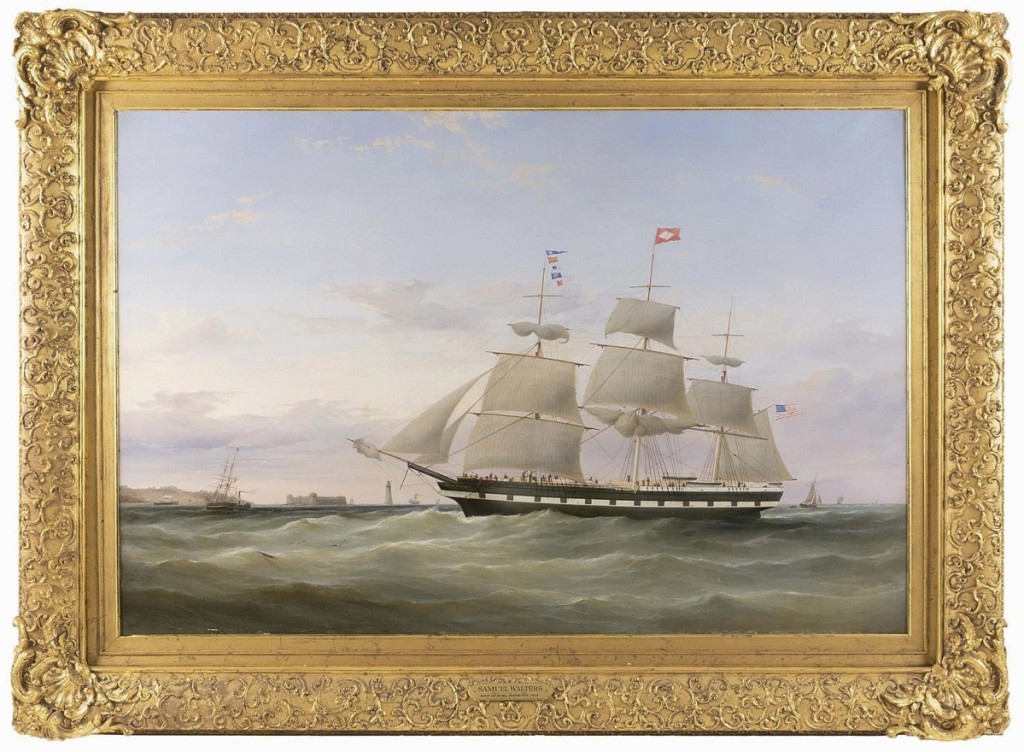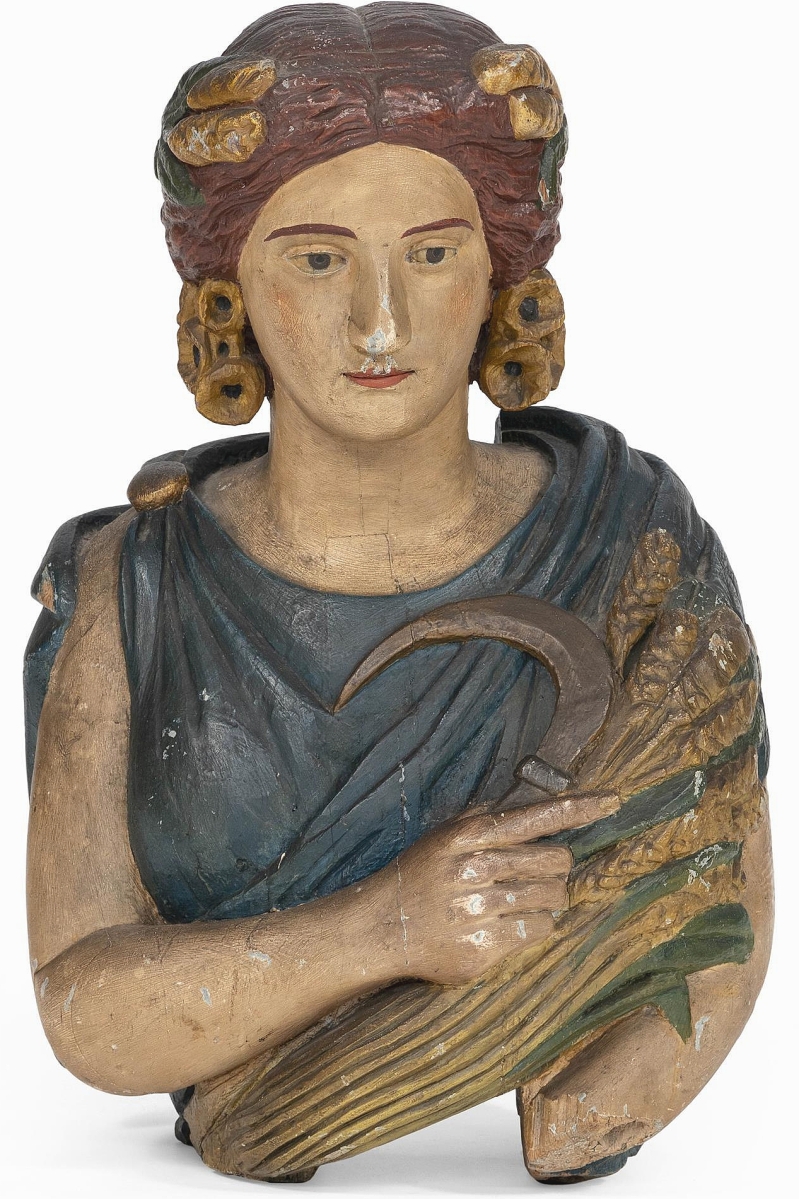
At $118,750, the sale’s top lot was this scrimshaw whale’s tooth by Edward Burdett. The sailor presumably carved it when he was aboard the William Tell from 1829 to 1833. He would die aged 28 on his very next voyage in late 1833, which makes his entire body of work very scarce. It was purchased by a private buyer.
Review by Greg Smith, Catalog Photos Courtesy Eldred’s
EAST DENNIS, MASS. – “Navigating 2020 could easily be compared with a captain weathering a fierce storm,” wrote Eldred’s president Josh Eldred in the foreword of the catalog for his August 13 Marine Sale. But that auction was smooth sailing as the collecting field awoke for the firm’s first offering from the collection of Richard Kelton, a prolific collector whose scholarly research and curatorial aid amounted to a museum-quality offering of material that has been in dispersal mode since his passing in 2019. Eighty-two works from Kelton’s collection were joined by those from 12 other consignors for the 441-lot sale, which grossed just north of $1.4 million.
Kelton formed the Kelton Foundation, a nonprofit designed to promote the stewardship, enhancement and understanding of maritime history through its collections of maritime art, navigational instruments, China Trade goods, Pacific tribal ethnographic materials and Aboriginal art. He was in part aided in acquisitions by maritime art scholar Sam Davidson.
“This sale brought out many collectors who had not been in the market for a long time, both institutional and private collectors,” said Gregg Dietrich, senior consultant and specialist at Eldred’s. “I’m going to say that a lot of it is because of Kelton’s name. People had a very high regard for what he collected, he was focused on some of the best material that came to the market. From painting to painting, I was amazed at the quality and the excellent condition of the things he bought. He had a very sharp eye and people knew that. That helped bring out collectors that I haven’t spoken to in years and it helped reinvigorate the market.”

A star from the Kelton Collection was William Bradford’s (American, 1823-1892) “Clipper Golden West of Boston, outward bound,” which sold for $59,375. In a letter to Kelton from Richard Kugler, who included the work in the book William Bradford—Sailing Ships & Arctic Seas and in an exhibition at the New Bedford Whaling Museum, Kugler writes of coming across an interview with Bradford where the artist recalls, “Captain Glidden (senior partner Glidden & Williams) gave me one hundred dollars for a picture about four feet long,” quite likely a reference to this 48-inch-wide image.
One area in which Kelton focused was the clipper ship era with both the transatlantic passage and the China trade. Artists featured included the Liverpool School artists Samuel Walters (United Kingdom, 1811-1882), Francis Hustwick (United Kingdom, 1797-1865), Duncan McFarlane (Mass./United Kingdom, 1834-1871) and others, including the Mediterranean port painters and southern French artists.
Selling for $33,750 was a Samuel Walters painting titled “The Packet Ship Daniel Webster Entering Liverpool,” which was a standout among the artist’s offerings and among the best Walters paintings the auction house had ever handled.
Dietrich noted that many of Kelton’s paintings, regardless of the artist, featured American flag vessels. The Walters painting was no different, originally commissioned and passed down through Enoch Train’s family, who owned the ship. Kelton had purchased it at Hyland Granby Antiques in 1998. Among other marine art books, Kelton’s adviser, Sam Davidson, wrote the title on the artist, Samuel Walters – Marine Artist (Jones-Sands Publishing, (Coventry, U.K., 1992).
Another Walters standout was a co-authored painting completed with his father Miles Walters (United Kingdom, 1773-1849) titled “American packet Sheffield approaching Liverpool,” executed 1831, which sold for $18,750. The Sheffield sailed for the Red Star Line on the Liverpool run for 13 years, before being sold and converted to a whaler out of Cold Spring Harbor, N.Y. Dietrich called it one of the nicest paintings in the sale, noting it was unlined, unrestored and original.

A private New York collection supplied a number of ivory pie crimpers in the sale, among them one with a snake handle that was in the collection of E. Norman Flayderman and illustrated in his book Scrimshaw and Scrimshanders, Whales and Whalemen. The crimper, which brought $18,750, dated to the mid-Nineteenth Century and was possibly in the collection of Meylert Armstrong, an early Twentieth Century pioneer in scrimshaw collecting. Marked with an “NH” to it, the catalog notes, “According to scrimshaw historian John Rinaldi, Flayderman purchased much of Meylert Armstrong’s collection out of his New Hope, Pennsylvania, home, marking the items ‘NH,’ standing for ‘New Hope,’ followed by a series of numbers. The Armstrong Collection formed the nucleus of Flayderman’s collection, and a substantial number of items illustrated in Flayderman’s book are from Armstrong’s collection.”
Kelton took an interest in other co-authored works, including those by the Yorke family of painters, William Gaye (1817-1888), his wife Mary E. (1854-1893) and son William H. (1847-1921).
“He had a particular fascination with the Yorke family,” Dietrich said. “In his research, he found that William Gay had an accident which affected his ability to paint, and that’s when his wife started helping with those canvases. After he passed away, we know she completed several of her own canvases, and then the son, William H., became a standout artist in his own right. Kelton was buying those paintings with the goal of eventually doing research on the Yorke family and putting it together in a book.”
Ten lots were offered from the Yorke family of artists with six finding buyers. The highest price paid at $15,000 was “New York Yacht Club schooner Columbia off Governor’s Island,” a circa 1889 oil on canvas. The Columbia won the 1971 America’s Cup. Commanding $7,500 were two co-authored paintings from William Gay and Mary E.: the circa 1893 “Sloop Albatross Under A Full Moon,” which was commissioned by brothers John and Louis Hohorst, both residents of Brooklyn, N.Y., and neighbors of Mary E. Yorke; and “Schooner yacht Atalanta of the New York Yacht Club arriving in Newport, Rhode Island,” executed in 1885. The lone appearance of William H. is in a co-authored work between him and his father, “The Capture of the Emily St Pierre by Federal Sloop James Adger,” executed in 1862. The painting descended through the family of Emily St Pierre‘s steward.

Josh Eldred said this painting by Samuel Walters (1811-1882) was one of the finest examples the firm had ever sold. “The packet ship Daniel Webster entering Liverpool” had provenance through the Train family, who owned the boat and commissioned the work through Walters. The 32-by-48-inch oil on canvas sold for $33,750. Kelton Collection.
The catalog provides the raucous story of the Emily St Pierre. “After sailing from Calcutta, the ship was nearing the bar at Charleston on March 18, 1862, when the USS James Adger stopped her on the grounds that her British registration was illegal, and the Emily St Pierre was taken into custody. The Confederate seamen were removed from the ship, with the exception of Louis Schelvin, the cook, Matthew Montgomery, the steward, and Captain Wilson, who was ordered to take his ship to Philadelphia. Wilson hatched a plan to recapture his ship, and he drew the cook and the steward into his confidence. While Lieutenant Josiah Stone, who was the acting master, was on watch, they bound and gagged the mate while he was asleep, and in another room the engineer was treated in the same manner. Wilson then requested Lieutenant Stone come to his cabin and check a chart, saying he was unsure his charts were correct. On the way, Wilson threatened Stone with an iron bar and tied him up so he could not raise the alarm. Wilson, now having taken the lieutenant’s gun, ushered three men and the helmsman into a hatch and locked them in. Wilson had now regained his vessel, but he was 3,000 miles from Liverpool with only the cook and a steward, neither of whom could reef nor steer. Eventually the prisoners agreed to assist and a month later, April 21, the ship anchored in the Mersey.”
Outside of Antonio Jacobsen (American/Danish, 1850-1921), who was represented by six paintings in the auction, one of the most notable works executed by an American in the Kelton collection was “Clipper Golden West of Boston, Outward Bound” by William Bradford (1823-1892). A large write up on the lot was provided from the extensive information that Kelton had gathered on the circa 1852 work, which went on to sell for $59,375. The painting had been exhibited twice and was featured in Richard Kugler’s 2003 title William Bradford – Sailing Ships & Arctic Seas. The catalog description noted “The 1,441-ton Golden West, as her name suggests, was active in the Pacific and California trades. Built for the Boston firm of Glidden & Williams, she was an extreme clipper, making several trips around Cape Horn trading between China, Australia and the American West Coast. She still holds the record for the fastest sailing passage between Japan and San Francisco – 4,876 miles in just over 20 days – under Captain Putnam, from May 13 to June 2, 1856.”
Kelton was also immersed in the travels of Captain James Cook. Representing that fancy was an early Twentieth Century 1/5′:1′ scale model of the HMS Endeavor, the same ship Cook used on his first exploration into the Pacific in 1768-81. It sold for $3,125.

Taking $12,500 was this early Twentieth Century bone model of a 56-gun ship done in the style of the prisoner-of-war models. The case measured 37¼ inches.
Eldred’s will continue to offer more material from the Kelton collection in a series of sales extending into 2021.
At $118,750, the sale found its lot leader in a scrimshaw whale’s tooth by Edward Burdett presumably carved when he was aboard the William Tell from 1829 to 1833. It was consigned from Sam and Donna McDowell, whose collection Eldred’s has been selling for over a year now. Burdett would die in 1833 on his following voyage, making the master carver’s works extremely scarce. The auction house said it was purchased by a private buyer.
A private New York collection supplied a number of ivory pie crimpers in the sale, among them one with a snake handle that was in the collection of E. Norman Flayderman and illustrated in his book Scrimshaw and Scrimshanders, Whales and Whalemen. The crimper, which brought $18,750, dated to the mid-Nineteenth Century and was possibly in the collection of Meylert Armstrong, an early Twentieth Century pioneer in scrimshaw collecting. Marked with an “NH” to it, the catalog notes, “According to scrimshaw historian John Rinaldi, Flayderman purchased much of Meylert Armstrong’s collection out of his New Hope, Pennsylvania, home, marking the items ‘NH,’ standing for ‘New Hope,’ followed by a series of numbers. The Armstrong Collection formed the nucleus of Flayderman’s collection, and a substantial number of items illustrated in Flayderman’s book are from Armstrong’s collection.”
A selection of 26 harpoons was led by a $3,500 result for a Snow & Purrington iron toggle harpoon from New Bedford, circa the Nineteenth Century. It came from the whaler Timberlane and had provenance to Nina and Bob Hellman, along with a number of the others on offer. Also with provenance to the Hellmans was a wrought iron double flue arctic harpoon, from the Nineteenth Century, off the whaleship William C Nye of New Bedford.
All prices include buyer’s premium, as stated by the auction house. For more information, www.eldreds.com or 508-385-3116.































